Wheat Growth and Development
Last updated on
February 23, 2014
Slide show (requires PowerPoint XP or later
version)
PDF of slides
The following is derived from three publications:
 Growth Staging of Wheat, Barley and Wild Oat
Growth Staging of Wheat, Barley and Wild Oat
 Growth and
Development Guide for Spring Wheat
Growth and
Development Guide for Spring Wheat
 Growth and
Development Guide for Spring Barley
Growth and
Development Guide for Spring Barley
Cereal Grain Development Scales
Staging Plants
Small Grain Growth Stages and Management
Profitable small grain production requires a thorough knowledge of crop development
and growth, and how cultural and environmental factors can influence crop development.
Crop and weed response to inputs such as fertilizers, pesticides, plant growth regulators
and supplemental irrigation depend on the stage of development rather than on calendar
date. Improper application timing may reduce chemical or fertilizer effectiveness,
and, in some cases, result in crop injury and yield loss.
Wheat ( Triticum aestivum L.) can be classified as winter or spring growth
habit based on flowering responses to cold temperatures. Winter wheat development
is promoted by exposure of the seedlings to temperatures in the 38 degrees to 46
degrees F range. Such types are usually planted in the fall which exposes the seedlings
to cold temperatures during late fall and winter. Spring-types, however, do not
require exposure to cold temperatures for normal development and can be planted
in spring. Both winter- and spring-types, when properly grown, head in the late
spring or early summer and mature by mid- to late-summer.

Barley ( Hordeum vulgare L. ) originated in the Eastern Mediterranean region.
Barley can be distinguished by differences in head type and growth habits. In a
six-rowed barley, three kernels are formed at each node of the head while in a two-rowed
type, only a single kernel forms at each node. Barley is also classed by its requirement
for cold temperatures. Winter barley must be planted so that seedlings will be exposed
to cold (vernalized), which enables it to later produce heads and grain normally.
Winter barley is usually sown in the fall for exposure to low temperatures during
the winter and then development is completed during the following spring and summer.
Spring barley does not require exposure to winter temperatures and can be sown in
spring. Winter types usually mature somewhat earlier than spring types. Differences
in maturity exist among varieties.


The development and growth of cereal grains have been translated into several numeric
scales to quantify development for scientific and management purposes. Industry
is now adopting these staging scales as a means of properly identifying application
times for certain products. The most commonly used scales are the Feekes, Zadoks
and Haun.
The Feekes scale is probably the best known and most widely used numerical
staging scale. Eleven development stages describe physical plant changes from the
first-leaf stage through grain ripening. For example, a six-leaf plant with one
node would be stage 6. The heading and ripening stages are subdivided for greater
detail. The Feekes scale recognizes eleven major growth stages starting with seedling
emergence and ending with grain ripening. The Feekes scale is frequently used to
identify optimum stages for chemical treatments, such as fungicide applications,
that focus on the plant development period from the start of stem elongation (Feekes
stage 6) to the completion of flowering (Feekes stage 10.53).
The Haun system is concerned mainly with the leaf production stage of development.
However, tiller and grain development are not described. A number, called a growth
unit, is assigned to each leaf as it develops, and to flag leaf sheath elongation,
booting, heading and peduncle elongation. Each growth unit is subdivided into decimal
fractions which begin with its own appearance and end with the appearance of the
next growth unit. The length of each emerging leaf is expressed as a fraction of
the length of the preceding fully emerged leaf. For example, a 3.2 indicates that
three leaves are fully emerged, and a fourth leaf has emerged two-tenths of the
length of the third. Although this system can be modified, it is not as useful in
the field where decisions are made using development indicators other than leaf
numbers.
The Zadoks scale provides more detailed information during early development
stages than the Feekes scale. The scale is based on ten principal plant development
stages, which are divided into secondary stages. A new leaf is counted as fully
emerged when 50 percent of the leaf blade has unfolded. Two or more codes may be
used to describe a plant using the Zadoks scale. For example, wheat that has six
leaves unfolded (16), three tillers (23) and one node on the main stem (31) would
be staged as 16, 23, 31.
The Zadoks system applies to any small grain and its stages are easy to identify
in the field. It is more detailed than other systems and allows for precise staging.
The first digit of this two-digit code refers to the principal stage of development
beginning with germination (stage 0) and ending with kernel ripening (stage 9).
Use of the second digit between 0 and 9 subdivides each principal growth stage.
A second digit value of 5 usually indicates the midpoint of the principal stage.
For example, a 75 refers to medium milk stage of kernel development. In seedling
growth, principal growth stage 1, the second digit refers to the number of emerged
leaves. To be counted, a leaf must be at least 50 percent emerged. A 13, for example,
indicates that three leaves are at least 50 percent emerged on the main shoot. Tiller
leaves are not counted.
For the tillering principal stage (stage 2), the second digit indicates the number
of emerged tillers present on the plant. Since stages may overlap, it is possible
to combine Zadoks indexes to provide a more complete description of a plant's appearance.
For example, a plant with one tiller and three leaves could be described by either
or both of the Zadoks stages 13 and 21. As the plant matures, the Zadoks stages
describing kernel development are usually used alone. For purposes of herbicide
application, the seedling stage (stage 1) identifying the leaf numbers is useful.
Another way of quantifying leaf appearance is in terms of accumulated heat units
calculated by summing the number of degrees above 40 degrees F for each day. Heat
units for each day are calculated with the following equation:
Growing degree unit = ((max. temp. + min. temp.)/2) - 40 degrees F
The ten major growth stages that the small grains plant progresses through during
its life cycle are all familiar to farmers:
- Germination
- Seedling
- Tillering
- Stem elongation or Jointing
- Booting
- Heading
- Flowering or Anthesis
- Milk
- Dough
- Ripening
|
Cereal grain development stages by Zadoks, Feekes and Haun scales.
|
|
Zadoks Scale
|
Feekes Scale
|
Haun Scale
|
Description
|
|
Germination
|
|
00
|
-
|
-
|
Dry Seed
|
|
01
|
-
|
-
|
Start of imbibition
|
|
03
|
-
|
-
|
Imbibition complete
|
|
05
|
-
|
-
|
Radicle emerged from seed
|
|
07
|
-
|
-
|
Coleoptile emerged from seed
|
|
09
|
-
|
0.0
|
Leaf just at coleoptile tip
|
|
Seedling Growth
|
|
10
|
1
|
-
|
First leaf through coleoptile
|
|
11
|
-
|
1.0
|
First leaf extended
|
|
12
|
-
|
1.+
|
Second leaf extending
|
|
13
|
-
|
2.+
|
Third leaf extending
|
|
14
|
-
|
3.+
|
Fourth leaf extending
|
|
15
|
-
|
4.+
|
Fifth leaf extending
|
|
16
|
-
|
5.+
|
Sixth leaf extending
|
|
17
|
-
|
6.+
|
Seventh leaf extending
|
|
18
|
-
|
7.+
|
Eighth leaf extending
|
|
19
|
-
|
-
|
Nine or more leaves extended
|
|
Tillering
|
|
20
|
-
|
-
|
Main shoot only
|
|
21
|
2
|
-
|
Main shoot and one tiller
|
|
22
|
-
|
-
|
Main shoot and two tillers
|
|
23
|
-
|
-
|
Main shoot and three tillers
|
|
24
|
-
|
-
|
Main shoot and four tillers
|
|
25
|
-
|
-
|
Main shoot and five tillers
|
|
26
|
3
|
-
|
Main shoot and six tillers
|
|
27
|
-
|
-
|
Main shoot and seven tillers
|
|
28
|
-
|
-
|
Main shoot and eight tillers
|
|
29
|
-
|
-
|
Main shoot and nine tillers
|
|
Stem Elongation
|
|
30
|
4-5
|
-
|
Psuedo-stem elongation
|
|
31
|
6
|
-
|
First node detectable
|
|
32
|
7
|
-
|
Second node detectable
|
|
33
|
-
|
-
|
Third node detectable
|
|
34
|
-
|
-
|
Fourth node detectable
|
|
35
|
-
|
-
|
Fifth node detectable
|
|
36
|
-
|
-
|
Sixth node detectable
|
|
37
|
8
|
-
|
Flag leaf just visible
|
|
39
|
9
|
-
|
Flag leaf ligule/collar just visible
|
|
Booting
|
|
40
|
-
|
-
|
-----
|
|
41
|
-
|
8-9
|
Flag leaf sheath extending
|
|
45
|
10
|
9.2
|
Boot just swollen
|
|
47
|
-
|
-
|
Flag leaf sheath opening
|
|
49
|
-
|
10.1
|
First awns visible
|
|
Inflorescence Emergence
|
|
50
|
10.1
|
10.2
|
First spikelet of inflorescence visible
|
|
53
|
10.2
|
-
|
1/4 of inflorescence emerged
|
|
55
|
10.3
|
10.5
|
1/2 of inflorescence emerged
|
|
57
|
10.4
|
10.7
|
3/4 of inflorescence emerged
|
|
59
|
10.5
|
11.0
|
Emergence of inflorescence completed
|
|
Anthesis
|
|
60
|
10.51
|
11.4
|
Beginning of anthesis
|
|
65
|
-
|
11.5
|
Anthesis 1/2 completed
|
|
69
|
-
|
11.6
|
Anthesis completed
|
|
Milk Development
|
|
70
|
-
|
-
|
-----
|
|
71
|
10.54
|
12.1
|
Kernel watery-ripe
|
|
73
|
-
|
13.0
|
Early milk
|
|
75
|
11.1
|
-
|
Medium milk
|
|
77
|
-
|
-
|
Late milk
|
|
Dough Development
|
|
80
|
-
|
-
|
-----
|
|
83
|
-
|
14.0
|
Early dough
|
|
85
|
11.2
|
-
|
Soft dough
|
|
87
|
-
|
15.0
|
Hard dough
|
|
Ripening
|
|
90
|
-
|
-
|
-----
|
|
91
|
11.3
|
-
|
Kernel hard (difficult to divide by thumbnail)
|
|
92
|
11.4
|
16.0
|
Kernel hard (can no longer be dented by thumbnail)
|
|
93
|
-
|
-
|
Kernel loosening in daytime
|
|
94
|
-
|
-
|
Overripe, straw dead and collapsing
|
|
95
|
-
|
-
|
Seed dormant
|
|
96
|
-
|
-
|
Viable seed giving 50% germination
|
|
97
|
-
|
-
|
Seed not dormant
|
|
98
|
-
|
-
|
Secondary dormancy induced
|
|
99
|
-
|
-
|
Secondary dormancy lost
|
How to Select Plants


|
|
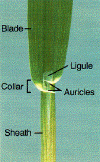
|

|

|
|
Characteristic
|
Barley
|
Wheat
|
Wild oat
|
|
ligule
|
membranous
|
membranous
|
membranous
|
|
auricles
|
short and hairy
|
long, clasping without hair
|
absent
|
|
blades and collars
|
usually hairy
|
without hair
|
long hair on margins
|
|
sheaths
|
usually hairy
|
without hair
|
usually without hair
|
|
blade twist
|
clockwise
|
clockwise
|
counter-clockwise
|
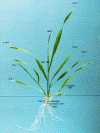
Locate the first leaf
The first leaf:
- Is the lowest leaf and has a blunt tip.
- May be dead or missing. Look for leaf and sheath remnants at the crown.
- Sheath encloses all later leaves.
- Arises on the opposite side of the plant as the coleoptilar tiller (if present)
and the remnants of the coleoptile.
Position the plant.
Hold plant so that the first leaf points to your left and carefully fan-out the
leaves and tillers. Follow this procedure for consistent results in staging.
Locate the main shoot or stem.
The main shoot or stem is usually the tallest and has the most leaves. Count the
leaves on the main shoot or stem. Leaves arise on opposite sides of the main shoot
or stem. Count the youngest leaf when it is at least one-half the length of the
leaf below it when using the Feekes or Zadoks scale. However, when using the Haun
scale, count the youngest leaf as a fraction of its length relative to the length
of the leaf below it. Dead or missing leaves must be counted. Look for leaf and
sheath remnants at the crown.
Count the tillers.
Each tiller has its own sheath called a prophyll belong to the main shoot or to
other tillers. Secondary and tertiary tillers also may be formed, so more than one
tiller may emerge from each leaf axil of the main shoot. Tillers that emerge after
the fifth leaf has emerged are not likely to produce heads and need not be counted.
Count the nodes.
Nodes can easily be seen or felt on the stem above ground level. If no nodes are
detected above ground, split the main shoot lengthwise to determine if stem elongation
has begun. The elongating internode is hollow between the crown and the elevated
growing point. In solid stem varieties the internode is not hollow but nodes are
still easily identified.
Has the flag leaf emerged?
The flag leaf emerges after at least three nodes are present above the soil surface.
To confirm flag leaf emergence, split the leaf sheath above the highest node. If
the developing head and no additional leaves are contained inside, then the last
leaf emerged was the flag leaf.
Has boot stage begun?
Boot stage in the Zadoks scale begins following emergence of the flag leaf collar
and continues until heading. In the Feekes and Haun scales, boot stage follows flat
leaf extension and continues until heading.
Has head emergence and flowering occurred?
Heading begins when the first awns become visible through the flag leaf collar.
Examine florets to determine if flowering has occurred. Most barley varieties flower
prior to head emergence while most wheat varieties flower following head emergence.
Determine grain development stage.
Grain development stages include watery ripe, milk, soft dough, hard dough, kernel
hard and harvest ripe.
Helpful Hints
All normal small grain plants follow the same general pattern of development. But
the specific time interval between stages, the number of leaves and nodes on the
main stem and number of tillers may very due to varieties, season, planting dates
and locations.
For example:
- An early-maturing variety may progress through some development stages at a faster
rate than a late-mature variety.
- The rate of development for any variety is directly related to temperature (accumulated
heat units), except under extremely dry conditions.
- The amount of grown (leaf size, number of tillers, etc.) for any variety is directly
related to nutrient and moisture availability.
Germination and Emergence





Under adequate growing conditions, the planted seed absorbs water and growth begins.
Metabolic activity within the seed rises sharply when seed water concentration approaches
45 to 49 percent. A root called the radicle is the first plant part to emerge from
the swollen seed. It elongates downward, anchors in the soil and absorbs water and
nutrients. The radicle and four to five later-emerging lateral seminal roots comprise
the primary root system. Following radicle emergence, the coleoptile emerges from
the seed and elongates until the tip breaks the soil surface, where elongation is
terminated in response to light. The coleoptile is a leaf sheath that encloses and
protects the embryonic plant.
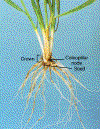
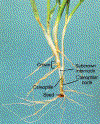
In wheat and barley, the coleoptile develops from the second or the third node on
the plant. Since these nodes are normally located in the seed and their internodes
do not elongate, the coleoptile originates from the level of seed. The internode
between the coleoptilar node and the next higher node, often called the subcrown
internode, has the ability to elongate and position the crown within one inch of
the soil surface. At planting depths to one inch this internode will not elongate
but at deeper planting depths it may elongate up to four inches if necessary. At
planting depths greater than three inches the next higher internode may also elongate.
A plant is judged completely emerged when 50 percent of the first leaf has emerged
from the coleoptile and begins expanding above the soil surface.
Several nodes, separated by internodes that do not elongate, from the crown. Leaves,
tillers and roots develop from the crown nodes. The node that bears the first leaf
is designated node 1; the second leaf is node 2; and so on. The coleoptilar node
is node 0 and the two nodes in the seed are designated negative numbers, such as
-1,-2, etc. Crown depth is determined by variety, planting depth and the extent
of internode elongation. The growing point is located at the crown until it is elevated
by stem elongation.
Leaf and Tiller Development
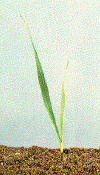 <
<



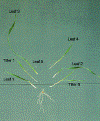

A new leaf is counted when it is one-half the length of the leaf below it when using
the Feekes of Zadoks scale. When using the Haun scale the development stage of the
youngest leaf is based on its length relative to the length of the leaf below it.
Great care must be exercised when staging plants with more than five leaves because
lower leaves die and are sloughed off the stem. Dead, dying or missing leaves must
be counted. Look for leaf and sheath remnants at the crown.
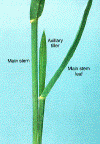
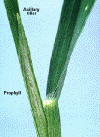

When the seedling has about three leaves, tillers usually begin to emerge. Ability
of plants to tiller is an important method of adapting to changing environmental
conditions. When environmental conditions are favorable or if the plant density
is reduced, compensation is possible by producing more tillers. Under typical cultural
conditions, tillers emerge during about a 2-week span with the total number formed
depending on the variety and environmental conditions. Deep seeding and high seeding
rates usually decrease the number of tillers formed per plant. There may be more
tillers formed when early season temperatures are low, when the plant population
is low, or when the soil nitrogen level is high. Some tillers initiate roots, contributing
to the nodal root system. About four weeks following crop emergence, some of the
previously formed tillers begin to die without forming a head. The extent to which
this premature tiller death occurs varies depending on the environmental conditions
and the variety. Under poor or stressed growing conditions, plants respond by forming
fewer tillers or by displaying more premature tiller death.
A tiller may form a bud located at the coleoptilar node (coleoptilar tiller) and
at each crown node (axillary tillers). The coleoptilar tiller can emerge at any
time, independent of the number of leaves on the main stem. Axillary tillers usually
begin to emerge when the plant has three leaves. Rarely are more than five axillary
tillers formed on a plant.
Tillers are identified numerically based on the leaf and node from which they arise.
The coleoptilar tiller, tiller 0, emerges from the axil of the coleoptile; tiller
one, from the first leaf axil and so on. Tiller leaves emerge from a sheath, called
the prophyll, which can later be found enclosing the base of the tiller. The prophyll
can be used to identify tiller leaves from those on the main stem or other tillers.
Secondary tillers may arise from the prophyll node and leaf nodes of the primary
tillers. In the same manner, tertiary tillers may occasionally be produced by secondary
tillers. The primary tillers are usually the tallest of the tillers that emerge
from a leaf axil. Leaves on primary tillers are positioned at right angles to the
main stem leaves.
Tillering capacity is a varietal trait and a physiological means of adapting to
changing environmental conditions. More tillers may be produced when environmental
conditions are favorable, plant populations are low, or soil fertility levels are
high. Under stress, plants respond by producing fewer tillers or by aborting initiated
tillers.
Tillers are counted as soon as they emerge above the soil surface or the leaf axil.
The contribution of each tiller to final yield is directly related to the development
stage achieved when reproductive development is initiated. Late developing tillers
contribute little to overall yield. Tillers that emerge after the fifth main shoot
leaf are likely to abort or not produce heads.
Adventitious Root Development
The adventitious or secondary root system is composed of roots that arise from the
crown nodes of the main shoot and tillers. Two or more adventitious roots are generally
formed at each crown node. Each tiller may produce its own adventitious root system
as does the main stem, except that a single root instead of a pair is usually reduced
at each node. The plant gradually becomes more dependent upon the adventitious root
system as it develops to become the predominant root mass.
Generally, by flowering, the root system is fully established. The adventitious
root system of spring wheat eventually becomes a profuse mass of fibrous roots,
which may penetrate the soil to a depth of three to four feet. Winter grains and
spring barley are generally deeper rooted than spring wheat. Degree of branching
and depth of penetration depend upon variety, type and depth of soil, soil compaction,
water, aeration and fertility level.
Wild Oat Development

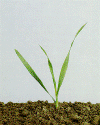
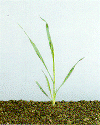
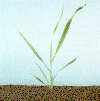
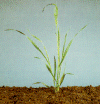
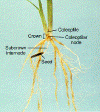
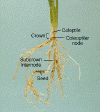
Wild oat is ranked as the worst weed problem by wheat and barley producers in many
western states. Wild oat infests more than 28 million acres of small grain in the
United States resulting in an estimated annual yield loss and prediction cost of
$304 million (WSSA Wild Oat Situation Report-1976.). Wheat and barley yields are
sharply affected by wild oat infestations. Ten wild oat plants per square feet can
reduce spring barley grain yield by 10 to 30 percent, depending on production practices
and environmental conditions. Winter wheat usually is more competitive against wild
oat than spring barley. Spring wheat is less competitive against wild oat compared
to spring barley.
Wild oat develop in a similar manner to wheat and barley with the exception of the
positioning of the coleoptilar node during seedling emergence. In wild oat, the
internode below the coleoptilar node elongates to elevate the shoot to within one
inch of the soil surface where the crown will form. The coleoptilar node is the
lowest-positioned crown node.
Wild oat susceptibility to post-emergence herbicides is influenced by development
stage. Tillers begin to emerge during the application time period for most wild
oat herbicides. The wild oat stage scales presented on product labels do not distinguish
between leaves and tillers which confuses product selection and application timing
decisions. To determine the proper time to apply the herbicide, some product labels
count tillers as leaves while other labels count only leaves and do not consider
tillers.
Head Initiation

Plant interactions with temperature and day length prompt the transition from vegetative
to reproductive stages. Reproductive development of true winter varieties is initiated
by vernalization during exposure to cool temperatures for a required length of time.
Temperatures between 32 and 50F induce cold hardening and satisfy vernalization
requirements. The required period of low temperature exposure varies with variety
and decreases with lower temperatures and advancing plant development. In addition
to vernalization, exposure to progressively longer day length periods is necessary
to initiate reproductive development. Spring varieties do not possess an absolute
vernalization requirement. Reproductive development in most spring varieties is
triggered by light and accumulative heat units (growing degree days).
The head or spike is initiated on each tiller during the fourth-leaf stage and before
stem elongation begins. The maximum number of kernels that may mature on each head
is determined by the number of florets that are initiated. Florets are first initiated
in the middle portion of the microscopic head and then outward toward the ends.
Stress conditions may cause florets to abort in the reverse order in which they
were initiated, resulting in empty or sterile florets at the ends of the head. Once
head formation is complete, stem elongation elevates the terminal growing point
of each tiller upwards within the leaf sheaths.
Stem Elongation





Stem elongation or jointing occurs as a result of internode elongation. Usually
a plant has about five to six leaves on the main shoot when internode elongation
first begins. Throughout development, the lower four nodes remain in the crown.
The fifth node may remain in the crown or be elevated slightly and nodes six and
seven are generally elevated above the soil. The elongating internode is hallow
between the crown and the elevated growing point, except in solid stem varieties.
Rapid stem or internode elongation brings the developing head above the soil surface.
Each elongation internode becomes progressively longer and eventually leads to head
emergence.

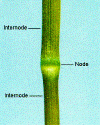

Stems can be split with a knife to determine if a plant is in early stem elongation
stage. As the internodes elongate, the nodes become visually detectable on the stem
and are easily counted. The mature stem of most wheat and barley varieties has form
three to four visible nodes.
The peduncle, the last elongated internode which supports the head, accounts for
a good proportion of the overall stem length. Height is genetically determined but
is subject to environmental influence. Certain growth regulators reduce plant height
and increase lodging resistance. Their application is timed to inhibit peduncle
elongation.
The period of rapid head growth in which individual florets become ready for pollination
and fertilization, parallels stem elongation. Tiller development is in synchronization
with the main stem so that tillers flower soon after the main stem.
Flag Leaf
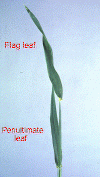



The flag leaf is the last leaf to emerge before the head. It begins to emerge just
after the third above-ground node is observed of most varieties. The flag leaf contributes
75 percent or more of the photosynthate needed for maximum grain yield. Flag leaf
emergence is a visual indicator that the plant will soon be in the boot stage.
Boot Swollen
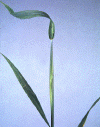
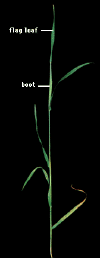
Following flag leaf development, the flag leaf sheath and the peduncle elongate
and the developing head is pushed up through the flag leaf sheath. The leaf sheath
swells to form the boot as the head continues to develop. The boot stage is complete
when the awns (or the head in awnless varieties) become visible at the flag leaf
collar and the sheath is forced open by the developing head.
Pollination usually takes place in barley just before or during head emergence from
the boot. Pollination begins in the central portion of the head and proceeds toward
the tip and base. Since pollen formation is sensitive to stress, water deficits
and high temperatures at this time will decrease the number of kernels that form
and may reduce yields. These yield reductions can be diminished by planting early
so that pollination and early grain filling is completed before late season stresses
occur.
Head Emergence and Flowering


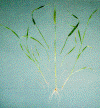
Heading occurs as the peduncle continues elongation and pushes the head out of the
flag leaf collar. Flowering (pollination) may occur either before or after head
emergence depending on plant species and variety. Pollen formation and pollination
are very sensitive to environmental conditions.
Cereals are classified as either open-flowering or closed-flowering types. Flowering
usually occurs in closed-flowering varieties prior to head emergence and in open-flowering
varieties shortly after head emergence. Many winter barley varieties are open-flowering
whereas spring barley varieties are usually closed-flowering. Most varieties of
wheat are of the open-flowering type.
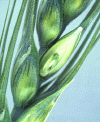
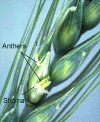
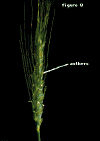
Flowering in open varieties is usually observed by anther extraction from each floret,
although this may not occur under stress conditions. In closed-flowering types,
the anthers remain inside each floret. If the anthers within a floret are yellow
or gray, rather than green, it is reasonably certain that flowering has occurred.
Generally, flowering in wheat begins within three or four days after head emergence,
while flowering in barley usually occurs just before or during head emergence. Flowering
begins from about the middle section of the main stem head and progress to the top
and bottom of the head. All heads of a plant flower within a few days. Within a
few hours of pollination, the embryo and endosperm begin to form.
Grain Development Stages
Watery Ripe Stage
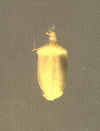
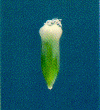
During the watery ripe stage, kernel length and width are established and the kernel
rapidly increases in size, but does not accumulate much dry matter. A clear fluid
can be squeezed from the developing kernel. The plant is green, but the lower leaves
begin to die.
Milk Stage

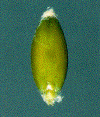
During the milk stage a white, milk like-fluid can be squeezed from the developing
kernel. By the end of milk stage the embryo is fully formed and about 1/32 inch
in length. During the course of this stage, nutrients stored in lower leaves are
redistributed to the upper plant, including the developing kernels, causing several
of the bottom leaves to die.
Soft Dough Stage

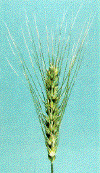

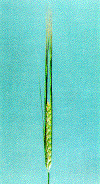
The water concentration of the kernel has decreased to the point where the material
pressed out of the kernel is no longer a liquid but has the consistency of meal
or dough. The kernel rapidly accumulates starch and nutrients and by the end of
this stage the green color begins to fade. Most of the kernel dry weight is accumulated
in this stage. In barley, the palea and lemma become firmly adhered to the kernel.
Once kernel water concentration decreases to about 75 percent, swathing of spring
wheat can begin without reducing yield, test weight, or protein level.
Hard dough stage
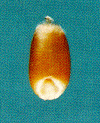

The kernel reaches physiological maturity at the end of this stage. At physiological
maturity, the glumes and peduncle are no longer green and little green coloring
remains in the plant. Kernel water concentration decreases from a level of 40 to
30 percent. The main reductions in yield beyond this stage result from harvest losses,
and environmental injuries, such as hail and sprouting.
Kernel Hard Stage

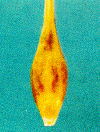

The plant has become completely yellow and the kernel has become firm. The kernel
is difficult to physically divide by thumbnail but the surface of the grain can
be dented with the edge of the thumbnail. Kernel water concentration is 20 to 25
percent. Unless drying facilities are available, the crop must be swathed and windowed
at this stage because the grain water concentration is too high for safe storage.
Harvest Ripe Storage

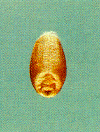



The plant has become dry and brittle and the kernel is hard. The kernel cannot be
crushed between thumbnails and is difficult to dent its surface with the edge of
the thumbnail. If the kernel is crushed by other means, it fragments. When the kernel
water concentration has decreased to 13 to 14 percent the grain is ready for direct
combining and storage.
Dry Matter Accumulation


Dry matter accumulation in the aerial parts of wheat and barley change with plant
development stage. From emergence to about the two-leaf stage, all of the aerial
dry matter is in leaves. From that stage forward, dry matter begins accumulating
rapidly in the stems. The developing head, which is initiated at about the four-leaf
stage, is regarded as part of the stem until heading. By the flag-leaf stage about
30 percent of the total aerial dry matter is accumulated and it is almost equally
distributed between leaves and stems. About 55 percent of the total aerial dry matter
is accumulated by the time the heads are completely emerged. Dry matter accumulation
in the stems declines after heading and all additional dry matter is accumulated
in the kernels. By kernel hard stage dry matter is distributed essentially between
stems and heads.
Adverse environmental conditions during any of the growth periods of a kernel can
reduce the rate of dry matter accumulation and decrease yield. As a rule, the longer
the adverse condition lasts, and the earlier it occurs during grain filling, the
greater its effect on yield.
Leaf area establishment and duration
Since photosynthesis provides energy for growth and dry matter for yield, it is
important that leaf area be established rapidly and protected throughout the growing
season. Early in the plant's growth, the leaf blades are the major photosynthetic
organs. The rate of leaf area establishment depends on temperature, but can be increased
by high nitrogen fertilization and seeding rates. The duration of leaf function
is also important for maximum grain yield. The maximum leaf area is usually reached
about heading, then declines during grain growth when the demand is great for photosynthate
(products of photosynthesis). As the lower leaves die, the upper leaf blades, leaf
sheaths, and heads become very important as photosynthetic sources for grain filling.
For maximum yields, the last two leaf blades and sheaths, as well as the head and
awns, are particularly important. Barley also has a limited capacity to mobilize
substances that were produced and stored earlier in the growing season if conditions
reduce the capacity of the plants to produce current photosynthate.
Glossary of Terms
Adventitious roots - Roots produced by crown nodes on the main shoot and tillers.
Anther - The reproductive portion of a flower which produces and releases the pollen.
Anthesis - The time of flowering or pollination.
Auricles - A pair of claw-like projections at the junction of the sheath and blade.
Axillary tillers - The tillers that emerge from the leaf axils.
Blade - The flat expanded portion of a leaf.
Coleoptile - The leaf sheath which surrounds and protects the embryonic plant as
it emerges from the seed.
Coleoptilar tiller - The tiller that emerges from the coleoptilar node.
Collar - The junction of the leaf blade and leaf sheath.
Crown - Several nodes whose internodes do not elongate.
Endosperm - The area of starch and protein storage in the kernel.
Floret - The flower contained in the spikelet.
Glumes - The husk of the spikelet.
Growing point - The plant part where differentiation of leaves, tillers and the
head occurs.
Internode - The region between two successive nodes.
Leaf axil - The junction of the leaf with the main stem.
Lemma - The outer, lower bract enclosing the flower in a spikelet.
Ligule - A short membrane or row of hairs of the inside of the leaf at the junction
of the blade and sheath.
Nodes - The area of active cell division from which leaves, tillers and adventitious
roots arise.
Palea - The inner, upper bract enclosing the flower in a spikelet.
Peduncle - The last elongated internode which supports the head.
Photosynthate - The products of photosynthesis.
Plant Growth Regulator - A chemical used to inhibit peduncle elongation and increase
lodging resistance.
Pollen - The powder-like matter produced by the anthers which functions as the male
element in pollination.
Pollination - Fertilization of the embryo by pollen.
Primary tiller - A tiller produced by a node on the main stem.
Prophyll - The sheath which encloses the base of a tiller.
Radicle - The first root to emerge from the seed.
Secondary tiller - A tiller produced by a primary tiller.
Seminal roots - The roots originating from the seed.
Sheath - The tubular portion of a grass leaf that encloses the stem.
Spikelet - Subdivision of the head.
Subcrown Internode - The internode between the coleoptilar node and the next higher
node which elongates to position the crown within one inch of the soil surface in
wheat and barley.
Tertiary tiller - A tiller produced by a secondary tiller.
Tiller - A shoot that arises from buds at the base of a plant.
Vernalization - Plants must be subjected to low temperatures for a period of time
before they enter the reproductive stages of development.
References
Anderson, P.M., E.A. Oelke, and S.R. Simmons. 1985.
Growth and Development Guide for Spring Barley . University of Minnesota
Agricultural Extension Folder AG-FO-2548.
Anderson, P. M., E.A. Oelke, and S.R. Simmons. 1985.
Growth and Development Guide for Spring Wheat . University of Minnesota
Agricultural Extension Folder AG-FO-2547
Bauer, A., C.V. Eberlein, J.W. Enz, and C. Fanning. 1984. Use of Growing-Degree
Days to Determine Spring Wheat Growth Stages. North Dakota State University Extension
Bulletin 37.
Bauer, A., C. Fanning, J. W. Enz and C. V. Eberlein. 1994. USE OF THE GROWING-DEGREE
DAYS TO DETERMINE SPRING WHEAT GROWTH STAGES. North Dakota Coop. Ext. Ser. EB-37.
Fargo, N.D.
Bauer, A., A. B. Frank and A. L. Black. 1984. ESTIMATION OF SPRING WHEAT LEAF GROWTH
RATES AND ANTHESIS FROM AIR TEMPERATURE. Agron. J. 76:829-835.
Bauer, A., A. B. Frank and A. L. Black. 1987. AERIAL PARTS OF HARD RED SPRING WHEAT.
I. DRY MATTER DISTRIBUTION BY PLANT DEVELOPMENT STAGE. Agron. J. 79:845-852.
Bauer, A., D. Smika and A. Black. 1983. CORRELATION OF FIVE WHEAT GROWTH STAGE SCALES
USED IN THE GREAT PLAINS. AAT-NC-7. Agricultural Research Service USDA.
Briggs, D. E. 1978. BARLEY. Chapman & Hall, London.
Dyer, W., P. Fay, P. Rardon and V. Stewart . 1983. THE WILD OAT STAGING CARD. Montana
Agricultural Experiment Station Capsule Information Series Number 30.
Haun, J. R. 1973. VISUAL QUANTIFICATION OF WHEAT DEVELOPMENT. Agron. J.65:116-119.
Klepper, B.,R. W. Rickman and C. M. Peterson. 1982. QUANTITATIVE CHARACTERIZATION
OF VEGETATIVE DEVELOPMENT OF SMALL CEREAL GRAINS. Agron. J. 74:789-792.
Klepper, B., R. W. Rickman and R. K. Belford. 1983. LEAF AND TILLER IDENTIFICATION
ON WHEAT PLANTS. Crop Sci. 23:1002-1004.
Large, E. B. 1954. GROWTH STAGES IN CEREALS. ILLUSTRATIONS OF THE FEEKES SCALE.
Plant Pathol. 3:128-129.
Peterson, C. M., B. Klepper and R. W. Rickman. 1982. TILLER DEVELOPMENT AT THE COLEOPTILAR
NODE IN WINTER WHEAT. Agron. J. 74:781-784.
Quisenberry, K. S. (Ed.) 1967. WHEAT AND WHEAT IMPROVEMENT. American Society of
Agronomy, Inc., Madison, Wisc.
Simmons, S. R., E. A.Oelke and P. M. Anderson. 1985. GROWTH AND DEVELOPMENT GUIDE
FOR SPRING WHEAT. University of Minnesota Agricultural Extension Folder AG-FO-2547.
Stoskopf, N. C. 1985. CEREAL GRAIN CROPS. Reston Publishing Company. Inc., Reston,
Virginia.
Waldren, R. P., and A. D. Flowerday. 1979. GROWTH STAGES AND DISTRIBUTION OF DRY
MATTER, N, P, AND K IN WINTER WHEAT. Agron. J. 71:391-397.
Zadoks, J. C., T. T. Chang and B. F. Konzak. 1974. A DECIMAL CODE FOR THE GROWTH
STAGES OF CEREALS. Weed Res. 14:415-421.